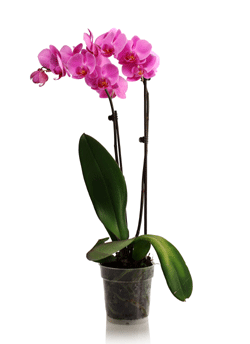
In this post, we will take a look at three other types of phalaenopsis orchid diseases, namely, wilts and rots, viruses, and flower-affecting disease.
If the roots of your orchid have developed a brown rot with white fungal growth and its leaves have shriveled and turned yellow, it means that it is affected by root rot. Root rot is caused by a fungal pathogen called rhizoctonia. To get rid of it, remove the infected roots and spray your orchid with a good quality, broad-spectrum fungicide, following package directions. Even if you suspect a bacterial disease, fungicide application will prevent secondary infection. Repotting your orchid in fresh medium is also recommended to remove the plant from the problem environment and improve its chances of recovery.
The symptoms of viruses, such as the tobacco mosaic virus, include reduced vigor, yellow striping, irregularly-shaped chlorotic lesions, dead leaf spots, downward leaf curling, and color break or dead spots on flowers. Since viruses cannot be treated, the best thing you can do is destroy or isolate infected orchids, and disinfect cutting tools to prevent transmission.
Botrytis blight and botrytis petal blight are caused by a fungus called botrytis cinerea, and they appear on the flowers of orchids as little brown spots that may become larger and have a pink margin. A gray spore mass may also appear if conditions favor the development of the disease. To control botrytis problems, you need to provide good sanitation and air circulation for your orchids, and avoid wetting their flowers and leaves when watering.
Check out our Orchid Diseases section to learn more about Phalaenopsis orchid diseases.

Copyright Just Add Ice® Orchids 2023